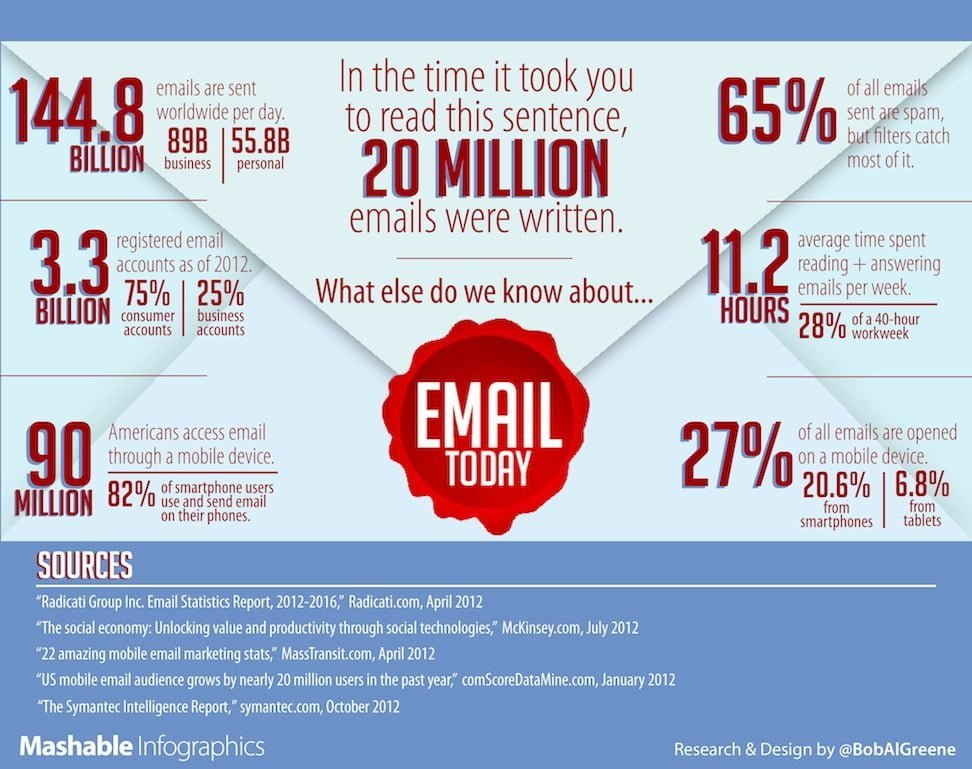Email usage: 12 worst practices and recommended strategies
![]() What are the 12 worst practices of Email usage in the workplace and what should be done about it? Email usage in the workplace is often afflicted with bad practices and this is a source of stress which one must take into account.
What are the 12 worst practices of Email usage in the workplace and what should be done about it? Email usage in the workplace is often afflicted with bad practices and this is a source of stress which one must take into account.
12 worst practices of e-mail usage in the workplace
and recommended strategies for increased productivity
As announced in a previous post, here is my analysis of e-mail usage (or misuse rather) in the workplace. I have also inserted my recommendations for productivity enhancement for each of the worst practice items which I have described. This is obviously not meant to be a comprehensive list. Feel free to add comments to this post and add items.
Email usage: 12 worst practices and recommended strategies

Introduction: we have all become ‘anoraks’
In the Internet world, e-mail can be considered one of the oldest web-related applications together with the late Gopher and newsnet. But e-mail per se already existed in the pre-Internet era. As far as I am concerned, I have been a user and observer of e-mail usage since its inception in the late 1980s when I was working for one of the leading IT providers of that time. That IT provider made the decision to extend the usage of e-mail (then in a proprietary format) to the entirety of the company’s users (i.e. 125,000 users across 35 countries but sadly enough far fewer today). The main issue with electronic mail at the time was about the requirement to make all employees including managers actually use it, the latter being rather reluctant. Indeed, many of them had difficulties coming to terms with the fact that their status was no hindrance to using the tool by themselves (many couldn’t associate typing with manager status, at the time it used to be secretarial work only). We were number 3 in the IT world at the time, but it didn’t make any difference in fact, strangely enough. All this to show our younger readers how far we’ve travelled in terms of IT usage since such prehistoric times.
A little less than 10 years after, the Internet revolution was making IT a cornerstone of work efficiency not only in businesses but also in schools, not to name the entertainment revolution in the home. In business, it has now virtually become impossible to name any profession not resorting to IT for their normal day to day operations. Luddites are now few and far between. To an extent, we have all become nerds. So much so that IT has now become just one more of our working tools, just like pen and paper, the mobile phone and other tools, just an ordinary tool, and no longer a subject for nerds/anoraks to discuss amongst themselves using incomprehensible three-letter acronyms.
However, despite the fact that IT has become ubiquitous, and even in spite of the Internet in particular, can we venture to say that we are all using it properly? In fact, there are many signs showing us that we are not. E-mail usage (be it in the business world or even on the open Internet) is very often inadequate, and can even be the source of conflicts in more in many ways.
Besides, e-mail usage has to face up to new and increasingly worrying problems: the exponential rise of spamming, e-mail overflow, e-mail addiction through devices like blackberry and other mobile Internet devices, not to name viruses. What I’m proposing here is an analysis of e-mail usage, its good and bad practices, and the strategies that are required in order to protect oneself from the side-effects of bad e-mail usage, and also more positively, positive strategies for better using this tool.
- Nobody understands how AI works - 23/03/2024
- Naturally Smart Writing, Beyond the Artificial - 18/03/2024
- LinkedIn’s new features under the microscope - 14/03/2024





As suggested by Sanne and Peter Christaens in their responses to my LinkeIn question
http://www.linkedin.com/answers?rateAnswers=&questionID=190499&askerID=179092&goback=.ait.mid_487540295.avq_190499_179092_0_*2
on the subject of no email fridays, I would urge you to read Joe Robinson’s E-Tool Bill of Rights at
http://www.worktolive.info/poen_arti.cfm
side note: following Mirek Polyniak’s response to my LinkedIn question (see above link), please check his post on his blog at
http://mirpo.livejournal.com/58792.html .
This will take you to a BBC article you should not miss.